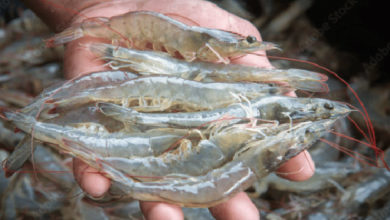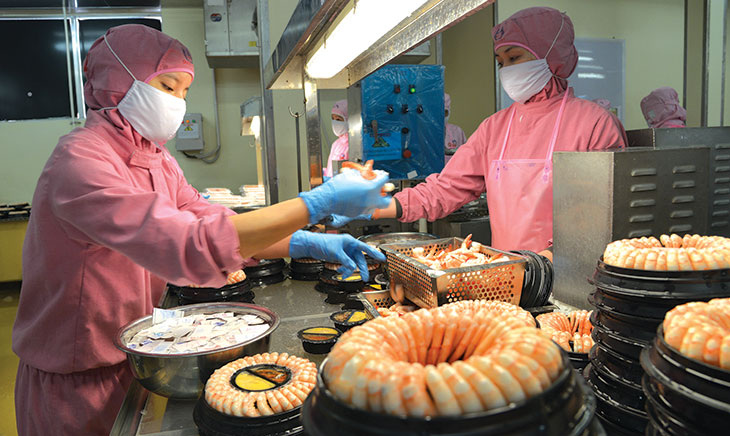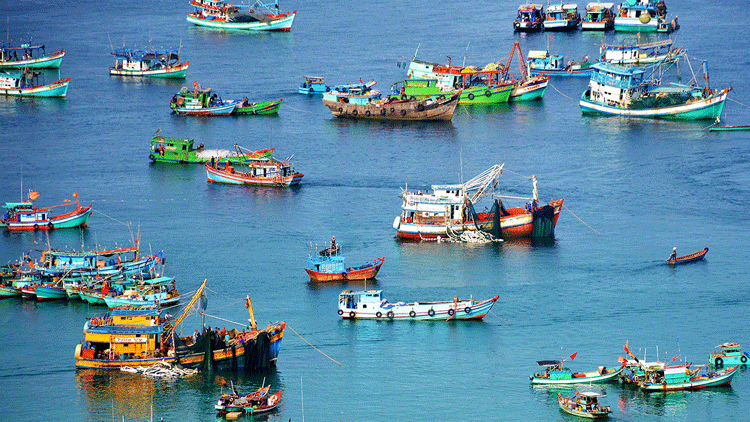TOMGOXY – A new digital paradigm for super intensive vannamei shrimp farming in rich oxygenation brackish water
The vannamei shrimp farming sector in the Mekong Delta of Vietnam is currently transitioning from “extensive earthen ponds” to “intensive farming in floating ponds fully lined with HDPE” and “super-intensive farming in floating ponds fully lined with HDPE and covered roofs” with the shrimp density reaching 500 shrimps/m2 in the grow out phase. To be able to use large amounts of feed in super intensive shrimp culture, with high shrimp density, dissolved oxygen concentration in the water must be stable and preferably higher than 5 mg/L. Maintaining a large amount of dissolved oxygen molecules in water is important for shrimps to grow and microbes to effectively decompose a large amount of organic waste from shrimp feces and uneaten feed to keep good water quality.
Mechanical aerating systems have been widely used to provide dissolved oxygen in intensive and super intensive vannamei shrimp farming in Vietnam. A typical mechanical aerating system combines a mechanical paddlewheel aerator that floats on the water surface and an air blower that connects with several ceramic or plastic air dispensers placed at the bottom of the ponds to diffuse air bubbles, containing 20.5% oxygen molecules and dissolve into the water column.
The basic physical limitation of this method is that the dissolved oxygen concentration in the water cannot be higher than the saturation of dissolved oxygen concentration in the water according to the gas transfer equation below:
dC/dt = Kl.(A/V).(DOs – DOm)
Wherein:
- dC/dt is the diffusion rate of oxygen molecules from the air bubbles into the water and back from the water column to air above the water surface;
- Kl is the water surface refresh constant depending on the rate of turbulent water flow;
- A is the surface area at the water and air interface;
- V is the volume of the water column of the shrimp pond;
- DOs is the saturation dissolved oxygen concentration in the water;
- DOm is the measurement dissolved oxygen concentration in the water.
In the Mekong Delta of Vietnam, DOs in brackish water is usually lower than 7.6 mg/L, and depends on the salinity of the water, the height of the shrimp pond above sea level, the water temperature, and other weather conditions during the day.
In order to maintain sufficiently high and stable DOm for commercial vannamei shrimp culture, the mechanical aerator must operate 24 hours a day. DOm is not customarily measured and monitored by farmers. This continuous operation consumes a lot of energy and does not take advantage of a large amount of dissolved oxygen molecules in the water, which are generated by the photosynthesis of algae in shrimp ponds during the day. Therefore, mechanical aerating systems are relatively low efficiency for generating dissolved oxygen, result in unstable dissolved oxygen concentration, and cause serious noise pollution from the air blower. The energy requirement to generate dissolved oxygen in water to produce one ton of shrimp is estimated to be between 3,500 and 7,500 kWh, depending on the weather conditions and type of equipment. The production cost for dissolved oxygen in a commercial shrimp farm, including electricity, depreciation, spare parts replacement and maintenance labor is estimated between 5 and 10%.
The development of the vannamei shrimp farming sector in Vietnam has been spectacularly successful in the last 20 years mainly due to the use of mechanical aerating system combining with chemicals and antibiotics for treating water and combating shrimp diseases. The use of biological and nutraceutical input materials to replace chemicals and antibiotics has become increasingly popular in recent years. However, the vannamei shrimp farming needs a new farming paradigm to overcome the technological limitations and farming challenges including:
- Low shrimp yield per hectare of land, due to the low ratio of cultural land to water treatment land;
- High loss of revenue from disease outbreaks per crop cycle, due to poor pathogen and water quality management;
- Poor quality shrimps sold in the domestic market (which are not fit for export), due to usually contamination with antibiotics, antibiotic resistant bacteria and chemicals;
- No shrimp traceability due to lack of investment in digital technology that automatically collects data in the farming stage and the shrimp value chain which is controlled by middlemen;
- High production cost of shrimps due to large amounts of imported raw materials for production of shrimp feed;
- High cost of energy for dissolved oxygen due to the use of low efficiency aeration system;
- Lack of responsibility of shrimp growers regarding environmental degradation and water pollution.

RYNAN® Technologies Vietnam is an innovative startup company in Travinh city. We focus on research, development, and application of digital technology, cloud computing, edge computing and artificial intelligence in agriculture and aquaculture. Recently, we have successfully developed and operated a new digital paradigm for super intensive vannamei shrimp farming in rich oxygenation brackish water, called TOMGOXYTM. Table 1 summarizes the characteristics of TOMGOXYTM super intensive vannamei shrimp farming in rich oxygenation brackish water with the current intensive and super intensive vannamei shrimp farming models.
The super intensive vannamei shrimp farming in rich oxygenation brackish water with digital technology TOMGOXYTM allows for increasing in shrimp density; replacing chemical methods with physical and biological methods; reducing of energy and water consumption per ton of shrimp; and obtaining antibiotic free high quality shrimps.
Table 1: summarizes the characteristics of TOMGOXYTM super intensive vannamei shrimp farming in rich oxygenation brackish water with the current intensive and super intensive vannamei shrimp farming models.







